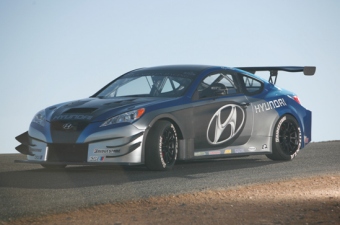
Automotive Intelligence - the web for automotive professionals and car enthusiasts
November 06, 2008
This Week:
-
Honda Reveals Accessory Concepts for Civic and Ridgeline at 2008 SEMA Show
-
BMW 5 Series And MINI COOPER Guarantee Highest Level Of Customer Satisfaction
-
INFINITI Demonstrates Inspired Performance At 2008 SEMA Show
-
Ford Takes Truck Leadership Off-Road With New F-150 SVT Raptor
-
New turbodiesel Mitsubishi Racing Lancer to make competition debut on Baja Portalegre
-
AUDI introduces new brand architecture in Tokyo heralds Audi quality of sales drive
© 1998 - 2008
Copyright &
Disclaimer
Automotive Intelligence,
www.autointell.com
All Rights Reserved .
For questions please contact
editor@autointell.net
|
Building The Rys Millen Racing Hyundai Genesis Coupé
LAS VEGAS - In February, Rhys Millen Racing (RMR) approached Hyundai Motor America with a unique concept to introduce the all-new 2010 Hyundai Genesis Coupe to the aftermarket and racing enthusiasts prior to its spring 2009 on-sale date. The RMR-designed “Art of Speed” Genesis Coupe called for a vehicle with the visual impact to win awards at the 2008 Specialty Equipment Market Association (SEMA) Show while boasting sufficient performance to put the driver in the winner’s circle the following weekend. Backed by Rhys Millen’s reputation both on the track and in the aftermarket, Hyundai delivered its first prototype Genesis Coupe 2.0T to the RMR shop on August 8, allowing just 12 weeks of build time before the doors opened at SEMA in Las Vegas on November 4. |
|
|
|
A crew of six RMR employees promptly stripped the car to bare metal. At the same time, the crew began custom-fabricating new aftermarket parts and accessories for the Genesis Coupe which are certain to be among the first available in the aftermarket once Hyundai’s newest addition takes to the streets next year. |

In the weeks that followed, RMR developed a machine that retains the distinct, bold look of the Genesis Coupe, but adds flair with custom components on the exterior, a radically altered racing-spec interior and serious performance enhancements from under the hood all the way to the pavement.
The interior of the “Art of Speed” Genesis Coupe is unrecognizable from its origins as a well-appointed 2+2 coupe designed with everyday driving in mind. All comfort and convenience features are removed to make way for a custom-fabricated eight-point safety cage and firewall which reinforce the Genesis Coupe’s already stiff chassis. By removing the roof, the RMR fabricators welded every aspect of the safety cage to the frame of the car. The braces on the A and B pillars also tie into the strength of the body. The safety cage is required for racing and a single Sparco racing seat further protects the driver in the overhauled cockpit.
Millen quickly decided to take the already light weight Genesis Coupe and make it even lighter. A second Genesis Coupe was used to construct molds which allowed body panels to be replicated out of carbon fiber. The carbon fiber panels range from 50 percent to 80 percent lighter than the sheet metal they replaced. This weight-saving approach is carried throughout the car without compromising its powerful curves, surface detail and “Z” bodyside line. The hood, deck lid, roof, doors, fenders, front fascia and side skirts are all built out of carbon fiber. For example, a factory Hyundai Genesis Coupe door weighs 68 pounds but modifications made by RMR reduce the door weight to just 8.5 pounds.
The side skirts have functional flat rocker panels with ducts to pull air out from underneath car. A functional splitter on the front fascia and a built-in diffuser create pressure without drag. A rear diffuser with long tunnels keeps the air moving underneath the car. Downforce has been further increased by an APR GTC-500 rear wing that is fully adjustable and was designed using Computational Fluid Dynamics (CFD) analysis. The hood is vented to dissipate heat and Aerocatch hood latches are used for safety.
The rear widebody fenders are made out of fiberglass and blend seamlessly into the vehicle design with a creative painting concept. The RMR Genesis Coupe utilizes a KW coilover suspension with two-way adjustable damping technology. Adjustable chrome molly sway bars dial the suspension in further for true track performance. RMR Racing also fabricated adjustable lower control arms.
The spirited 2.0-liter turbocharged engine which comes standard on the Genesis Coupe 2.0T is enhanced by a Turbonetics turbocharger, waistgate and blow-off valve to provide extra horsepower and torque. RMR also designed a custom intake manifold to ensure better engine breathing.
Photos: Hyundai
(Nov. 04, 2008)
| .
Homepage News Companies Management Publications Events Guestbook Search . |
